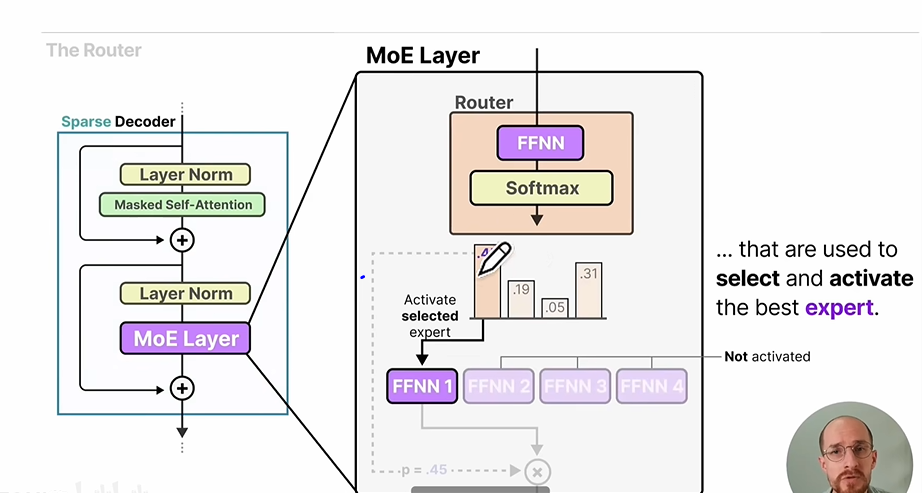DeepSeek模型MOE结构代码详解
其实在DeepSeek-R1爆火之前,DeepSeek V2在我们行业就已经妇孺皆知了,它独特的MOE结构值得研究一下。这篇文章是基于 ZOMI酱 的2个视频写的,这2个视频讲的很好,建议大家都学习一下:《MOE终于迎来可视化解读!傻瓜都能看懂MoE核心原理!》和《使用昇腾NPU手撕MoE单机版代码!没想到如此简单!》。
这篇文章是把我自己的理解梳理一下,加强自己的理解和记忆。
MOE结构概述
我们可以从zomi酱视频里面的这张图开始:
MOE是mixture of experts 的缩写,简单来说,就是把传统transformer结构中decoder层里面的单个线性层替换层多个并列的线性层。在这些线性层前面还有一个Router,Router会选择并列线性层里面的一部分进行计算。这样的话,既能让模型学习更多的知识(多个"专家"),又能减少推理计算量(选择部分"专家"进行计算)。
MOE计算代码
接下来我们参考zomi酱提供的代码来详细看一下MOE的计算过程是怎样的:
import torch
import torch.nn as nn
import torch.nn.functional as F
import torch_npu
from torch_npu.contrib import transfer_to_npu
class Expert(nn.Module):
def __init__(self, input_dim, hidden_dim, output_dim):
super().__init__()
self.net = nn.Sequential(
nn.Linear(input_dim, hidden_dim),
nn.GELU(),
nn.Linear(hidden_dim, output_dim))
def forward(self, x):
return self.net(x)
class MoE(nn.Module):
def __init__(self, input_dim, num_experts, top_k, expert_capacity, hidden_dim, output_dim):
super().__init__()
self.num_experts = num_experts
self.top_k = top_k
self.expert_capacity = expert_capacity
# 路由网络
self.gate = nn.Linear(input_dim, num_experts)
# 专家集合
self.experts = nn.ModuleList(
[Expert(input_dim, hidden_dim, output_dim) for _ in range(num_experts)])
def forward(self, x):
batch_size, input_dim = x.shape
device = x.device
# 路由计算
logits = self.gate(x)
probs = torch.softmax(logits, dim=-1)
print("probs: ", probs)
topk_probs, topk_indices = torch.topk(probs, self.top_k, dim=-1)
print("topk_probs: ", topk_probs)
print("topk_indices: ", topk_indices)
# 辅助损失计算
if self.training:
# 重要性损失(专家利用率均衡)
importance = probs.sum(0)
importance_loss = torch.var(importance) / (self.num_experts ** 2)
# 负载均衡损失(样本分配均衡)
mask = torch.zeros_like(probs, dtype=torch.bool)
mask.scatter_(1, topk_indices, True)
routing_probs = probs * mask
expert_usage = mask.float().mean(0)
routing_weights = routing_probs.mean(0)
load_balance_loss = self.num_experts * (expert_usage * routing_weights).sum()
aux_loss = importance_loss + load_balance_loss
else:
aux_loss = 0.0
# 专家分配逻辑
flat_indices = topk_indices.view(-1)
flat_probs = topk_probs.view(-1)
sample_indices = torch.arange(batch_size, device=device)[:, None]\
.expand(-1, self.top_k).flatten()
print("sample_indices: ", sample_indices)
# 初始化输出
outputs = torch.zeros(batch_size, self.experts[0].net[-1].out_features,
device=device)
# 处理每个专家
for expert_idx in range(self.num_experts):
print("expert_idx: ", expert_idx)
# 获取分配给当前专家的样本
expert_mask = flat_indices == expert_idx
print("expert_mask: ", expert_mask)
expert_samples = sample_indices[expert_mask]
print("expert_samples: ", expert_samples)
expert_weights = flat_probs[expert_mask]
print("expert_weights: ", expert_weights)
# 容量控制
if len(expert_samples) > self.expert_capacity:
expert_samples = expert_samples[:self.expert_capacity]
expert_weights = expert_weights[:self.expert_capacity]
if len(expert_samples) == 0:
continue
# 处理专家计算
expert_input = x[expert_samples]
print("expert_input: ", expert_input)
expert_output = self.experts[expert_idx](expert_input)
weighted_output = expert_output * expert_weights.unsqueeze(-1)
# 累加输出
outputs.index_add_(0, expert_samples, weighted_output)
return outputs, aux_loss
# 测试示例
if __name__ == "__main__":
input_dim = 5
output_dim = 10
num_experts = 8
top_k = 3
expert_capacity = 32
hidden_dim = 512
batch_size = 10
# add
device = torch.device("npu:4" if torch.npu.is_available() else "cpu")
moe = MoE(input_dim, num_experts, top_k, expert_capacity, hidden_dim, output_dim).to(device)
x = torch.randn(batch_size, input_dim).to(device)
moe.eval()
output, _ = moe(x)
print(f"Eval output shape: {output.shape}") # torch.Size([64, 256])
初始化函数定义
首先,定义了Expert类,也就是"专家",可以看到,专家是由线性层和激活函数构成的简单模型。
然后开始定义MOE类。在初始化函数中,定义了这样几个变量:
self.num_experts:专家的数量,也就是上面提到的"并列线性层"的个数,训练后的每个专家的权重都是不同的,代表它们所掌握的"知识"是不同的。
self.top_k:每个输入token激活的专家数量。
self.expert_capacity:代表计算每组token时,每个专家能被选择的最多次数。
self.gate:路由网络,一般是一个线性层,用来计算每个专家被选择的概率。
self.experts:实例化Expert类,生成多个专家。
前向计算逻辑
接下来看一下forward函数。为了方便大家理解,我们把上面代码的执行打印结果也一起附上。
首先是输入x,shape是(batch_size, input_dim),batch_size我们可以看作是token的数量,也就是序列长度。然后通过self.gate和softmax计算每个token在每个专家上的激活概率:
logits = self.gate(x)
probs = torch.softmax(logits, dim=-1)
probs的打印结果如下:我们设置的batch_size是10,num_experts是8,所以probs是个10行8列的矩阵。
probs: tensor([[0.1710, 0.1348, 0.0746, 0.1714, 0.0594, 0.2695, 0.0251, 0.0940],
[0.1556, 0.0776, 0.1658, 0.1489, 0.1152, 0.1679, 0.0565, 0.1124],
[0.1077, 0.1154, 0.1564, 0.1317, 0.0630, 0.2026, 0.0518, 0.1715],
[0.0681, 0.0680, 0.1236, 0.1030, 0.1707, 0.2827, 0.0627, 0.1211],
[0.0453, 0.0648, 0.2313, 0.0781, 0.1026, 0.1304, 0.1326, 0.2149],
[0.1394, 0.2278, 0.0625, 0.1832, 0.0395, 0.1512, 0.0691, 0.1274],
[0.1096, 0.1462, 0.1302, 0.1397, 0.0607, 0.1898, 0.0639, 0.1598],
[0.1200, 0.1952, 0.0970, 0.1648, 0.0360, 0.1072, 0.1018, 0.1779],
[0.0650, 0.0501, 0.1463, 0.1025, 0.2219, 0.1446, 0.1439, 0.1257],
[0.0641, 0.0813, 0.0579, 0.1348, 0.1170, 0.0631, 0.3554, 0.1264]],
device='npu:4', grad_fn=<SoftmaxBackward0>)
接着,再用topk算子把每个token的激活专家选出来:
topk_probs, topk_indices = torch.topk(probs, self.top_k, dim=-1)
topk_probs和topk_indices 的打印结果如下,因为我们设置的top_k=3,所以每个token都把排名前三的概率选出来了,同时topk_indices把这些概率对应的专家编号也选出来了,比如第0个token,激活了5号专家、3号专家、0号专家。
topk_probs: tensor([[0.2695, 0.1714, 0.1710],
[0.1679, 0.1658, 0.1556],
[0.2026, 0.1715, 0.1564],
[0.2827, 0.1707, 0.1236],
[0.2313, 0.2149, 0.1326],
[0.2278, 0.1832, 0.1512],
[0.1898, 0.1598, 0.1462],
[0.1952, 0.1779, 0.1648],
[0.2219, 0.1463, 0.1446],
[0.3554, 0.1348, 0.1264]], device='npu:4', grad_fn=<TopkBackward0>)
topk_indices: tensor([[5, 3, 0],
[5, 2, 0],
[5, 7, 2],
[5, 4, 2],
[2, 7, 6],
[1, 3, 5],
[5, 7, 1],
[1, 7, 3],
[4, 2, 5],
[6, 3, 7]], device='npu:4')
self.training分支对应的是训练过程中计算损失函数的部分,我们后面再讲。
选择好专家后,就要开始计算了。计算规则是,对于每个token,假如它选择的专家是e1、e2、e3,概率分别是p1、p2、p3,那么这个token的计算结果就是p1e1_out+p2e2_out+p3*e3_out。
由于计算个体是每个专家,所以代码中用for循环遍历每个专家。我们以第0个专家为例,看看它的计算过程是怎样的。
首先需要确定0号专家的输入。由于不是每个token都选择了0号专家,所以不能把x直接作为输入,而是要确定一个下标向量idxes,把x[idxes]作为0号专家的输入,idxes的值就是激活了0号专家的所有token编号,那么怎么得到idxes呢?代码里面是这样做的:
首先计算一个mask:
expert_mask = flat_indices == expert_idx
打印结果如下:
expert_mask: tensor([False, False, True, False, False, True, False, False, False, False,
False, False, False, False, False, False, False, False, False, False,
False, False, False, False, False, False, False, False, False, False],
device='npu:4')
flat_indices是topk_indices平铺之后的向量。通过对比,可以看到expert_mask中True的位置和topk_indices中0的位置铺平之后是一致的,代表第0个专家被第0个token和第1个token激活了。
而且expert_mask代表的含义是:只要它的第0-2的位置是True的话,就代表被第0个token激活了,只要它的第3-5的位置是True的话,就代表被第1个token激活了,以此类推,我们可以声明一个sample_indices向量:
sample_indices: tensor([0, 0, 0, 1, 1, 1, 2, 2, 2, 3, 3, 3, 4, 4, 4, 5, 5, 5, 6, 6, 6, 7, 7, 7,
8, 8, 8, 9, 9, 9], device='npu:4
再通过下面的代码就可以把idxes取出来了:
expert_samples = sample_indices[expert_mask]
也顺便把概率权重取出来:
expert_weights = flat_probs[expert_mask]
接着把输入取出来:
expert_input = x[expert_samples]
打印结果如下:
expert_samples: tensor([0, 1], device='npu:4')
expert_weights: tensor([0.1710, 0.1556], device='npu:4', grad_fn=<IndexBackward0>)
expert_input: tensor([[-1.4382, -1.5939, 0.0802, -0.5614, 0.2586],
[-1.2631, 1.0266, 0.1806, -0.7280, -0.6913]], device='npu:4')
再进行专家计算:
expert_output = self.experts[expert_idx](expert_input)
weighted_output = expert_output * expert_weights.unsqueeze(-1)
最后还需要把计算结果叠加到对应的token上面去:
outputs.index_add_(0, expert_samples, weighted_output)
完成上面的for循环之后,就把所有专家的计算任务完成了,通过index_add_的操作,把每个token的计算结果也汇总了。
损失函数
损失函数包含2部分:专家利用率均衡和样本分配均衡。
首先是专家利用率均衡,如果每个专家被选择的概率相近,那么说明分配越均衡,损失函数越小:
importance = probs.sum(0)
importance_loss = torch.var(importance) / (self.num_experts ** 2)
然后是样本分配均衡,首先得到每个token、每个专家的分配概率矩阵:
mask = torch.zeros_like(probs, dtype=torch.bool)
mask.scatter_(1, topk_indices, True)
routing_probs = probs * mask
然后按照token维度(样本维度)求平均,得到每个专家被分配的token平均数量和平均概率:
expert_usage = mask.float().mean(0)
routing_weights = routing_probs.mean
两者相乘求和得到负载均衡损失:
load_balance_loss = self.num_experts * (expert_usage * routing_weights).sum()
样本分配越均衡,这个损失函数越小。举个例子,10个专家,10个样本,如果所有样本都分到1个专家,那么损失函数值为10x1+0+0...+0=10,如果平均分给10个专家,那么损失函数值为1x0.1+1x0.1+...+1x0.1=1。
本文由博客一文多发平台 OpenWrite 发布!





